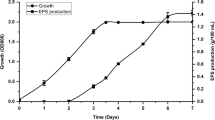Abstract
Psychrophilic Antarctic yeasts produce polysaccharides in different concentrations. According to morphological, cultural, physiological and biochemical characteristics, the best producer strain was identified as Cryptococcus flavus A51. The highest values for viscosity (59.1 mPa s) and crude polysaccharide productivity (5.75 g/L) were obtained in a medium containing 5 % sucrose and 0.25 % (NH4)2SO4, at 24 °C for 6 d. The chemical composition and sugar constituents of the crude exopolysaccharide were determined (92.5 % saccharides, 3.34 % protein, and 4.16 % ash). The monosaccharide composition of the exopolysaccharide obtained from C. flavus strain AL51 was established (55.1 % mannose, 26.1 % glucose, 9.60 % xylose, 1.90 % galactose). The microbial biopolymer has a high molar mass and homogeneity: 82 % of it had M 1.01 MDa.
Similar content being viewed by others
Abbreviations
- DBB:
-
diazonium blue B (a test)
- HPSEC:
-
high-performance size-exclusion chromatography
- EPS:
-
exopolysaccharide(s)
References
Adami A., Cavazzoni V.: Exopolysaccharides produced by some yeast strains. Annal.Microbiol.Enzimol. 40, 245–253 (1990).
Barnett J.A., Payne R.W., Yarrow D.: Yeasts:Characteristics and Identification. Cambridge University Press 1990.
Blakeney A., Harris P., Henry R., Stony B.: A simple and rapid preparation of alditol acetates for monosaccharide analysis. Carbohydr. Res. 113, 291–299 (1983).
Chiura H., Iizuka M., Yamamoto T.: A glucomannan as an extracellular product of Candida utilis. I. Production and characterization of a glucomannan. Agric.Biol.Chem. 46, 1723–1733 (1982a).
Chiura H., Iizuka M., Yamamoto T.: A glucomannan as an extracellular product of Candida utilis. II. Structure of a glucomannan characterization of oligosaccarides obtained by partial hydrolysis. Agric.Biol.Chem. 46, 1733–1742 (1982b).
D’Amico S., Collins T., Marx J.C., Feller G., Gerday C.: Psychrophilic microorganisms: challenges for life. EMBO Rep. 4, 385–389 (2006).
Dubois M., Gilles K., Hamilton Y., Rebers P., Smith F.: Colorimetric method for determination of sugars and related substances. Anal.Chem. 28, 350–356 (1956).
Elinov N.P., Ananieva E.P., Vitovskaya G.A.: Features of the biosynthesis and characteristics of the exoglucanns in yeasts of the genus Sporobolomyces. Mikrobiologiya 60, 466–470 (1992).
Friedman E.I.: Antarctic Microbiology. Wiley-Liss, New York 1993.
Kuncheva M., Pavlova K., Panchev I., Dobreva S.: Emulsifying power of mannan and glucomannan produced by yeasts. Internat. J.Cosmetic Sci. 29, 377–384 (2007).
Kurzman C.P., Fell J.W.: The Yeasts: a Taxonomic Study, 4th ed. Elsevier Sci. Publ., Amsterdam (Netherlands) 1998.
Lacroix C., Leduy A., Noel G., Choplin L.: Effect of pH on the batch fermentation of pullulan from sucrose medium. Biotechnol. Bioeng. 27, 202–207 (1995).
Lambo A., Patel T.: Cometabolic degradation of polychlorinated biphenyls at low temperature by psychrotolerant bacterium Hydrogenophaga sp. IA3-A. Curr.Microbiol. 1, 48–52 (2006).
Margaritis A., Pase G.W.: Microbial Polysaccharides. Comprehensive Biotechnology, Vol. 3, pp. 1005–1041. Pergamon Press, Oxford 1985.
Margesin R., Fauster V., Fonteyne P.A.: Characterization of cold-active pectate lyases from psychrophilic Mrakia frigida. Lett. Appl.Microbiol. 6, 453–459 (2005).
Nakagawa T., Nagaoka T., Taniguchi S., Miyaji T., Tomizuka N.: Isolation and characterization psychrophilic yeasts producing cold adapted pectinolytic enzymes. Lett.Appl.Microbiol. 38, 383–387 (2004).
Pavlova K., Grigorova D.: Production and properties of exopolysaccharides by Rhodotorula acheniorum MC. Food Res.Internat. 32, 473–477 (1999).
Pavlova K., Grigorova D., Gushterova A.: Preliminary investigations about the isolation of yeasts from Livingston Island, Antarctica. Bulg.Res.Antarctica Live Sci. 2, 110–114 (1999).
Pavlova K., Koleva L., Kratchanova M., Panchev I.: Production and characterization of an exopolysaccharide by yeast. World J.Microbiol.Biotechnol. 20, 435–439 (2004).
Pavlova K., Gargova S., Hristozova T., Tankova Z.: Phytase from Antarctic yeast strain Cryptococcus laurentii AL27. Folia Microbiol. 53, 29–34 (2008).
Peterson G.R., Nelson G.A., Cathey C.A., Fuller G.G.: Rheologically interesting polysaccharides from yeasts. Appl.Biochem.Biotechnol. 20–21, 845–867 (1989).
Ruberto L., Vazquez S., Lobalbo A., Maccormack W.P.: Psychrotolerant hydrocarbon-degrading Rhodococcus strains isolated from polluted Antarctic soils. Antarctic Sci. 1, 47–56 (2005).
Sabri A., Bare G., Jacques P.: Influence of moderate temperatures on myristoyl-CoA metabolism and acyl-CoA thioesterase activity in the psychrophilic Antarctic yeast Rhodotorula aurantiaca. J.Biol.Chem. 16, 12691–12696 (2001).
Sandford P.A., Cotterell L.W., Pettitt D.J.: Microbial polysaccharides: new products and their commercial applications. Pure Appl.Chem. 56, 879–895 (1984).
Scorzetti G., Petrescu L., Yarrow D., Fell J.W.: Cryptococcus adeliensis sp.nov., a xylanase producing basidiomycetous yeast from Antarctica. Antonie van Leeuwenhoek 2, 153–157 (2000).
Vandamme E., Bruggeman G., Baets S., Vanhooven P.: Useful polymers of microbial origin. Agr.Food Industry Hitech. 7, 21–25 (1996).
Vincent W.F.: Evolutionary origins of Antarctic microbiota: invasion, selection and endemism. Antarctic Sci. 3, 374–385 (2000).
Vorotynskaya S.L., Vitovskaya G.A., Ananyeva E.P.: Studies on the properties of polysaccharides produced by the yeasts Cryptococcus luteolus (SAITO) skinner. Mikrobiol.Fitopatol. 26, 367–371 (1992).
Welander U.: Microbial degradation of organic pollutants in soil in a cold climate. Soil Sediment Contam. 3, 281–291 (2005).
Willims P., Hickey M., Mitchell D.: Fluid gels based on natural polysaccharides for cosmetic applications. Cosmet.Toiletr.Magaz. 118, 51–59 (2003).
Wynn-Williams D.D.: Antarctic microbial diversity: basis of polar ecosystems process. Biodivers.Conserv. 5, 1271–1294 (1996).
Zlatanov M., Pavlova K., Grigorova D.: Lipid composition of some yeast strains from Livingston Island, Antarctica. Folia Microbiol. 46, 402–406 (2001).
Author information
Authors and Affiliations
Corresponding author
Rights and permissions
About this article
Cite this article
Pavlova, K., Panchev, I., Krachanova, M. et al. Production of an exopolysaccharide by Antarctic yeast. Folia Microbiol 54, 343–348 (2009). https://doi.org/10.1007/s12223-009-0049-y
Received:
Revised:
Published:
Issue Date:
DOI: https://doi.org/10.1007/s12223-009-0049-y




